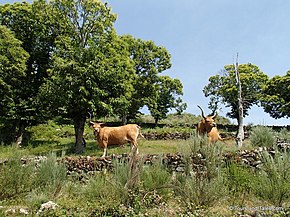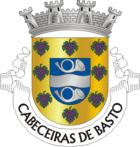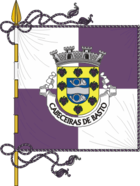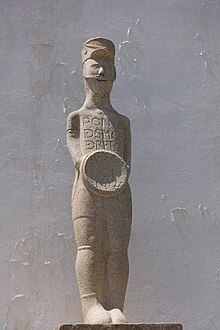Cabeceiras de Basto
| Cabeceiras de Basto | ||||||
|---|---|---|---|---|---|---|
|
||||||
| Basic data | ||||||
| Region : | Norte | |||||
| Sub-region : | Ave | |||||
| District : | Braga | |||||
| Concelho : | Cabeceiras de Basto | |||||
| Coordinates : | 41 ° 31 ′ N , 8 ° 0 ′ W | |||||
| Residents: | 711 (as of June 30, 2011) | |||||
| Surface: | 24.52 km² (as of January 1, 2010) | |||||
| Population density : | 29 inhabitants per km² | |||||
| Postal code : | 4860-355 | |||||
| politics | ||||||
| Mayor : | José Carlos Ferreira Rebelo ( PS ) | |||||
| Address of the municipal administration: | Junta de Freguesia de Cabeceiras de Basto Praça da República 4860-355 Cabeceiras de Basto |
|||||
| Cabeceiras de Basto district | ||||||
|
||||||
| Residents: | 16,710 (as of June 30, 2011) | |||||
| Surface: | 241.82 km² (as of January 1, 2010) | |||||
| Population density : | 69 inhabitants per km² | |||||
| Number of municipalities : | 12 | |||||
| administration | ||||||
| Administration address: | Câmara Municipal de Cabeceiras de Basto Praça da República 4860-355 Cabeceiras de Basto |
|||||
| President of the Câmara Municipal: | Francisco Alves ( PS ) | |||||
| Website: | www.cm-cabeceiras-basto.pt | |||||
Cabeceiras de Basto is a small town (vila) in Portugal .
history
Dolmens and other finds prove a prehistoric settlement up to the Castro culture . Of particular note are the finds by Chacim and Outeirinho de Mouros in the municipality of Refojos , and those by Formigueiro in the municipality of Rio Douro . A gold lunula and two gold disks from the Bronze Age were found.
An early monastery dedicated to the Archangel Michael was built here, probably after the arrival of the Suebi 406, or from 585 in the Visigoth Empire . In 711 the Arabs conquered the monastery and town and largely destroyed them in the process. Cabeceiras de Basto was probably repopulated during the Reconquista in the 12th century. A new monastery was built here in the early 12th century and was the destination of numerous pilgrims, including famous people such as Inês de Castro and Nuno Álvares Pereira , who married here in 1376 .
In 1514 the place was given city rights by King D. Manuel . Later on, Cabeceiras de Basto gained some cultural relevance. It was mentioned in works by Sá de Miranda (in Carta a D. António Pereira ), Bernardim Ribeiro , and especially Camilo Castelo Branco , especially in Bruxa de Monte Cordova and Noites de Lamego .
The place name
A widespread explanation of the place name goes back to the alleged foundation by members of the Bastos ( Bástulos or Bastianos ) who had arrived here , a population group from Galicia who were expelled in 711 after the attacks by the Moors . Tariq ibn Ziyad (Tarik) conquered the Visigothic Empire , to which Cabeceiras de Basto belonged, in 711 and largely destroyed the town.
Another explanation sees the origin of the place name in the time of the Roman presence and the Latin term vastu or pastu , with reference to the local pastures. Cabeceiras is assumed to have originated from the Latin capitia and the later plural suffix eiras , so that the place name originally meant something like "excellent rich pastures".
Another explanation is based on a granite statue from the 1st century BC. In the place, which was probably edited several times in the 17th and 19th centuries. You should the Lusitanian represent warriors Basto, who is said to have been as a name sponsor.
The explanation of the place name based on a traditional legend was particularly widespread among the population. The monk knight Hermígio Romarigues , from the family of the founders of the first monastery São Miguel de Refojos de Basto , is said to have defended the place in 711 against the attacking army of Tarik. He is said to have stood in front of the bridge to the monastery and called out to the attackers: Até alí, por São Miguel, até alí, basto eu! (German for example: "Up to here and no further, for the sake of St. Michael , to here and no further, I should be sufficient for that!"). As a result, three attacks by the Arabs are said to have remained unsuccessful and the monk knight from then on was called Basto (German: I suffice). According to legend, the granite statue in the village is said to represent the knight "Basto".
administration
The circle
Cabeceiras de Basto is the seat of a district of the same name ( concelho ) in the Braga district . On June 30, 2011, the district had 16,710 inhabitants on an area of 241.8 km².
The neighboring areas are (starting clockwise in the north): Montalegre , Boticas , Ribeira de Pena , Mondim de Basto , Celorico de Basto , Fafe and Vieira do Minho .

With the regional reform in September 2013, several municipalities were merged into new municipalities, so that the number of municipalities decreased from 17 to twelve.
The following municipalities ( Freguesias ) are in the Cabeceiras de Basto district:
| local community | Population (2011) |
Area km² |
Density of population / km² |
LAU code |
|---|---|---|---|---|
| Abadim | 571 | 15.14 | 38 | 030401 |
| Alvite e Passos | 1,184 | 12.19 | 97 | 030418 |
| Arco de Baúlhe e Vila Nune | 2,048 | 9.04 | 227 | 030419 |
| Basto | 938 | 5.58 | 168 | 030404 |
| Bucos | 554 | 17.80 | 31 | 030405 |
| Cabeceiras de Basto | 711 | 24.52 | 29 | 030406 |
| Cavez | 1,268 | 26.79 | 47 | 030407 |
| Faia | 558 | 5.15 | 108 | 030408 |
| Gondiães e Vilar de Cunhas | 421 | 41.38 | 10 | 030420 |
| Pedraça | 760 | 12.17 | 62 | 030413 |
| Refojos de Basto, Outeiro e Painzela | 6,755 | 28.95 | 233 | 030421 |
| Rio Douro | 942 | 43.11 | 22nd | 030415 |
| Cabeceiras de Basto district | 16,710 | 241.82 | 69 | 0304 |
Population development
| Population in the county of Cabeceiras de Basto (1801–2011) | ||||||||
|---|---|---|---|---|---|---|---|---|
| 1801 | 1849 | 1900 | 1930 | 1960 | 1981 | 1991 | 2001 | 2011 |
| 8224 | 14,087 | 16,284 | 17,273 | 21,141 | 18,997 | 16,368 | 17,846 | 16,709 |
Municipal holiday
- September 29th
Town twinning
-
 Neuville-sur-Saône , France (since 1997)
Neuville-sur-Saône , France (since 1997) -
 Boa Vista , Cape Verde (since 2009)
Boa Vista , Cape Verde (since 2009) -
 Lalín , Galicia , Spain (since 2012)
Lalín , Galicia , Spain (since 2012)
In addition, two municipalities maintain other partnerships:
- Cavez municipality : Quincieux in the Rhône department (since 2005/2006)

- Refojos de Basto municipality : Rives in the canton of Rives (since 2008)

traffic
Cabeceiras de Basto is connected to the A7 motorway via the junction in the municipality of Basto .
Until the cessation of passenger traffic in 1990, the district with the station in Arco de Baúlhe had a connection to the Linha do Tâmega railway line .
Cabeceiras de Basto is integrated into the national long-distance bus network of Rede Expressos .
The public transport in the county is publicly chartered buses from private bus companies Mondinense and Transdev operated.
sons and daughters of the town
- Francisco Guedes de Carvalho Meneses da Costa (1757–1833), noble colonial administrator, 1797–1801 Governor of Mozambique
- Joaquim José Insley Pacheco (1830–1912), photographer, painter and draftsman, imperial court photographer in Brazil
- Júlio Augusto Henriques (1838–1928), botanist and university professor
- Francisco Alves de Oliveira (1848–1917), bookseller and benefactor in Brazil
- Baltazar Castro (1891–1967), architect, important restorer
- Herculano Mendes (1904–1975), track and field athlete, Portuguese record hammer and discus thrower
- Arnaldo Pereira Leite (1908–1958), engineer and transport politician in the Estado Novo regime, head of the Caminhos de Ferro de Angola
- Joaquim dos Santos (1936–2008), spiritual composer
literature
- Thomas G. Schattner (Ed.): Archaeological guide through Portugal (= cultural history of the ancient world . Vol. 74). Philipp von Zabern, Mainz 1998, ISBN 3-8053-2313-1 p. 74
Web links
- Map of the Freguesia Cabeceiras de Basto at the Instituto Geográfico do Exército
- Official website of the city administration
Individual evidence
- ↑ www.ine.pt - indicator resident population by place of residence and sex; Decennial in the database of the Instituto Nacional de Estatística
- ↑ a b Overview of code assignments from Freguesias on epp.eurostat.ec.europa.eu
- ↑ a b www.ine.pt - indicator resident population by place of residence and sex; Decennial in the database of the Instituto Nacional de Estatística
- ↑ www.verportugal.net , accessed January 10, 2014
- ^ João Fonseca: Dicionário do Nome das Terras . 2nd edition, Casa das Letras, Cruz Quebrada 2007, p. 62f ( ISBN 978-9724617305 )
- ^ Publication of the administrative reorganization in the Diário da República gazette of January 28, 2013, accessed on March 16, 2014
- ^ Page of the town twinning on the website of the town administration, accessed on March 3, 2014
- ↑ Overview of the bus routes in the district on the city administration website, accessed on March 3, 2014







